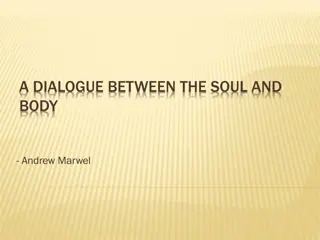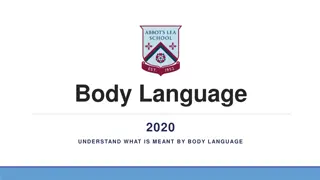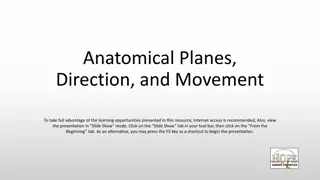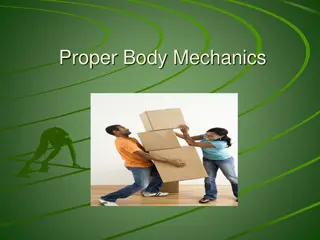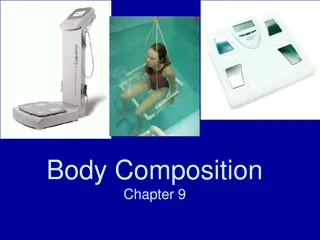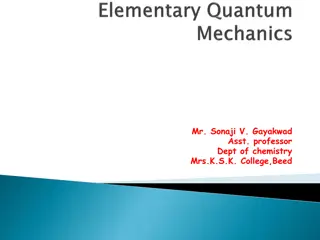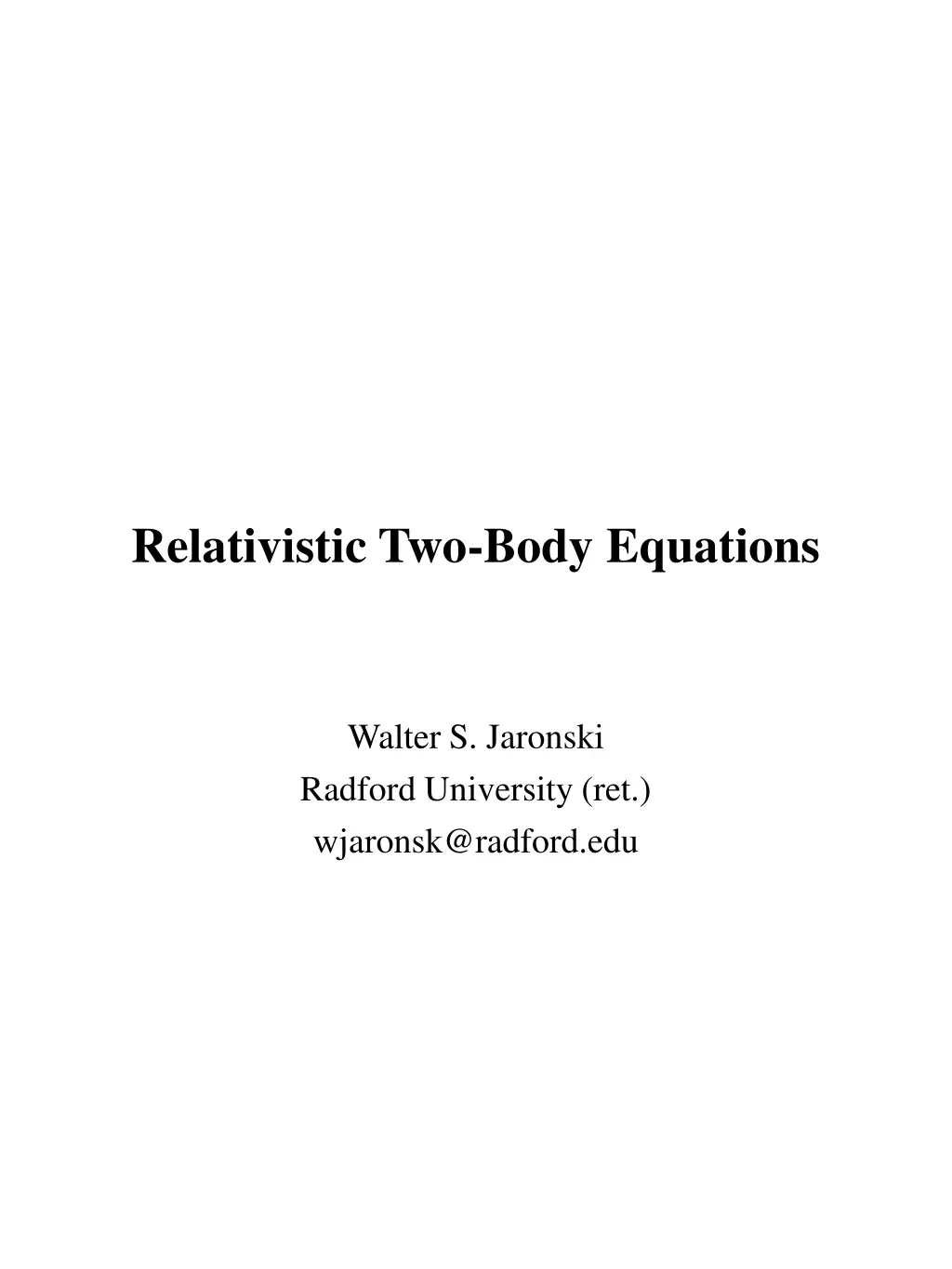
Relativistic Two-Body Equations and Quantum Mechanics Challenges
Explore the challenges posed by relativistic two-body equations in both classical and quantum mechanics, focusing on issues such as proper time, center of mass, and particle creation. Dive into the complexities of treating bound states in quantum field theory and consider alternate approaches for a relativistic quantum mechanical treatment of the two-body problem.
Download Presentation

Please find below an Image/Link to download the presentation.
The content on the website is provided AS IS for your information and personal use only. It may not be sold, licensed, or shared on other websites without obtaining consent from the author. If you encounter any issues during the download, it is possible that the publisher has removed the file from their server.
You are allowed to download the files provided on this website for personal or commercial use, subject to the condition that they are used lawfully. All files are the property of their respective owners.
The content on the website is provided AS IS for your information and personal use only. It may not be sold, licensed, or shared on other websites without obtaining consent from the author.
E N D
Presentation Transcript
Relativistic Two-Body Equations Walter S. Jaronski Radford University (ret.) wjaronsk@radford.edu
There are many issues with relativistic two- body equations both classical and quantum mechanical. Classical - How do we deal with each particle having its own proper time? - There is no simple analog of the center of mass. - Jordan-Currie-Sudarshan no-go theorem (Rev. Mod. Phys. 35, 350 (1963). [Classical Hamiltonian formalism + Lorentz invariance no interaction] Quantum - JCS theorem does not apply (QFT) but the other two issues remain. We use the center of momentum frame, but the problem of the relative time remains. - In addition, there is a new problem particle creation and annihilation. If the particle number is not fixed, how can we restrict ourselves to a two-body equation?
Since we live in a quantum, and not classical, world, I will now restrict the discussion to the quantum case. The last difficulty in the quantum case is often viewed as the most serious and can lead to a complete disregard of relativistic quantum mechanics (as opposed to quantum field theory). For example, I note the following quote from Weinberg: relativistic wave mechanics, in the sense of a relativistic quantum theory of a fixed number of particles, is an impossibility. (The Quantum Theory of Fields, vol. I, p. 3) So, perhaps it is fruitless to seek a simple wave equation of the nonrelativistic form, and we must only use field theory. This may be true ideally . . .
But . . . It is very difficult to treat bound states in QFT. The most standard QFT tool for bound states is the Bethe-Salpeter equation. But this itself has many problems: mathematical difficulty, uncertain approximations, interpretation of some solutions. (Quasipotential approaches ameliorate some of these issues and have been quite successful, but I will say no more about this there are much more qualified people here at CEBAF to address this topic.) My attitude: field theory is the theory for particle physics. However, as a practical matter, its treatment of bound states is not completely satisfactory. There is room for a relativistic quantum mechanical treatment of the two-body problem. Even if we lose a little bit in rigor, it is helpful to have an equation which is more manageable and perhaps, calling on our experience with nonrelativistic quantum mechanics, somewhat more intuitively intelligible.
I will consider two approaches: - two-body Dirac equation with constraint dynamics - the Breit equation with instantaneous interaction I will focus on the latter, but let me first say a few words about the former. It is motivated by Dirac s theory of constraints. Dirac s concern in this theory is more fundamental than the simple constraints encountered in elementary Lagrangian mechanics. A starting resource for this theory is Dirac, Lectures on Quantum Mechanics (Yeshiva University, New York, 1964) Applications of this to the Dirac two-body problem has been treated in many papers by Crater, Van Alstine and collaborators for example: Crater, Horace W; Van Alstine, Peter , "Two-body Dirac equations , Annals of Physics 148, 57 (1983) The main idea is the use of constraints to eliminate the relative time and relative energy in the center of momentum frame.
Second approach Breit (two-body Dirac) with instantaneous potential. (Malenfant, Phys. Rev. D 38, 3295 (1988), but with some differences) This approach suffers from one serious defect: it is not covariant. Therefore, it is not truly relativistic it is only semi-relativistic. However, it does incorporate relativistic kinematics and spin, and reduces to the Dirac equation in the infinite limit of the mass of one of the particles. The two-body Dirac equation we will study: [( ?1 ? + ?1(?1+ ?1))????? + ??? + ? ? ?????? ??= ? ??. Here, ??is a 4x4 matrix eigenvector: ?2 ? + ?2?2+ ?2)?? 13 23 33 43 14 24 34 44 11 21 31 41 12 22 32 42 ??= The use of this matrix form is a matter of convenience. It is easier than using a 16- component column vector. Also, the division by quadrants is meaningful.
Some additional comments about the equation: - V is a Lorentz vector potential and S is a Lorentz scalar potential. This distinction can be clarified by considering the (one-body) Dirac equation: ? ? + ? + ? + ? ? = ?? Note that S enters in the same way as the scalar m and V like the energy, which is the zero component of a Lorentz vector. - Although we are making the instantaneous approximation, this is still an improvement over some other potential model approaches for example, the spinless Salpeter equation, which uses a Schr dinger-type equation with relativistic kinematics: ?2+ ?1 ?2+ ?2 (Stanley & Robson, Phys. Rev. D 21, 3180 (1980)) Since there is no spin in this equation, it must be put in by hand usually by including spin-spin, spin-orbit, and tensor terms to the potential, in addition to the central term. The mass dependence of these terms is often standard, but some parametrization may be allowed. 2+ 2+ ? ? = ?? .
In contrast, the two-body Dirac has these spin dependencies included automatically. - Although we are dealing with a two-particle equation, we can consider it as the two- particle sector in Fock (Vladimir Fock, 1898- 1974) space. We can then, if we choose, allow coupling to a four-component sector due to pair creation. All we need is a pair- production operator to provide the coupling - - but that is the subject for a different talk. Returning to our equation and writing out the separate equation for each component, we obtain 31 41 1 = (? ?1 ?1 ?2 ?2) 11 plus 15 other similar equations. In this equation, ? is the standard 2 x 2 Pauli matrix and the subscript on the square bracket means the upper ( 1 ) component of the vector obtained by the matrix multiplication inside the bracket. 13 14 ? ? ? ? + ? 11 1
Now we want to consider special cases. We are interested in quarkonium. So ?1= ?2 and we will take ?1= ?2 ?/2. The lowest- lying state should be the pseudoscalar 0 (0 The spin-angular form of the eigenvector matrix is 1? spin 0,orbital L = 0,total J = 0) state. = sin?? ???1 cos??1 0 0 ? ? 0 cos??1 sin?????1 sin?? ???2 cos??2 cos??2 sin?????2 0 , where ?,?1,?2,and are all functions of r. The top left and bottom right quadrants are spin-singlet states written in matrix form, the upper right and lower left quadrants are spin 1 and orbital angular momentum 1 coupled to J = 0.
Returning to the component equations referred to above, we can then use ? ? = ? ? ?? ??+ ?1 ? 1 ? = ? ? ??+ ? . ? ?sin? ?? Now, with the expressions for the spherical unit vectors in terms of the Cartesian ones and the standard forms of the Pauli matrices ??,??,??, we get ? ? ? ?? sin?? ?? cos? cos? sin???? = ? ? ? cos?? ?? sin? sin? cos???? ? ?? ? ? ?? ?? 0 0 ???? ?sin? ?? We can now use this expression and the spin- angular form of the matrix eigenvector given above to obtain the equations for the radial functions:
?? ???1+ ?2 +2? ?1+ ?2 + ?? = ? ?1 ?2 ? ? ? ??? ??+ ?? ??+ ??1= (? ?1+ ?2)?1 ??? ??+ ?? ??+ ??2= (? + ?1 ?2)?2 ?? ???1+ ?2 +2? ?1+ ?2 + ? = ? + ?1+ ?2+ ? ? For quarkonium, ?1= ?2 ? and then ?1= ?2 ? and ? 2? ? ? ? = ? + 2? + ? ? . So, we are left with only two equations: 2??? ?? + ?? = ? 2? ? ? ??? ???? + ?? = ?? ??+4? ??+ ??
where we have taken ? 2? ? ? ? + 2? + ? ? = ?? = ? . To make the equations real, we take g ig and we also use reduced radial wave functions u and v, defined by f = u/r , g = v/r. This gives 2?? ?? 2? ?? ?? 1 + ? ?+ ?? = ? 2? ? ? ? ?+ ?? ?? 1 + ? ? + ?? = ?? . We will now apply this to the 0 state of charmonium, ??. We will use the Cornell potential (Eichten et al., Phys. Rev. Lett. 34, 369 (1975)) ? ?+ ?? But we will choose the vector potential to be ? = ? ?+ ??? and the scalar potential to be ? = ??? . This will allow us to adjust the vector-scalar mix in the linear potential.
The two differential equations are then solved numerically. With the following choice of parameters: ? = 1.2 GeV,? = 0.29,??= ??= 0.08 GeV2, we obtain a bound state at E = 2.876 GeV. The experimental value is 2.983 GeV. We are interested in the effect of the vector- scalar mix in the linear potential on bound states. There are a number of reasons for believing that we will not have bound states if the linear potential is pure vector. Our analysis is that we must have at least a 50/50 mix. Summary data: ?? ?? Comment Energy (GeV) 0 0.16 2.901 Quasi-bound 0.04 0.12 2.888 Quasi-bound 0.08 0.08 2.876 Bound 0.12 0.04 2.865 Bound 0.16 0 2.855 Bound
Why are the states with ??> ??only quasi- bound? The scalar potential lowers the negative-energy states and the vector raises them. If the vector is larger than the scalar, it can raise them to the energy of the quasi- bound state where they can mix with this state. This is in agreement with previous work on the one-body Dirac equation. ( The linear potential and the Dirac equation, arXiv:2108.0593 [quant-ph], 12 Aug 2021).
Application to the J = 1 state. This will allow us to treat the famous J/ state at 3097 MeV. One might think this would not be too much more difficult than the J = 0 case, but, in fact, it is considerably more complicated. This is due to the fact that one must include both L = 0, S = 1 and L = 2, S = 1 coupled to J = 1 components in the upper- upper and lower-lower parts of the matrix eigenfunction. The matrix is now 3? ??sin?cos??2 ?0 (3cos2? 1)?2 sin?? ???2 cos??2 ?? (3cos2? 1)?2 3???sin?cos??2 cos??2 sin??1??2 sin?? ???1 cos??1 cos??1 sin?????1 0+ (3cos2? 1) 2 3???sin? cos? 2 3???sin?cos? 2 0+ (3cos2? 1) 2 It is interesting that we need to include the L = 2 component; in the nonrelativistic treatment, we must use a tensor potential to induce this mixing. Here, this is included in the equation itself. Proceeding in the same fashion as in the pseudoscalar case results in six first-order differential equations. With some manipulation of these a pair of mixed second- order differential equations can be obtained. The solution of these is ongoing.
Appendix I: theory of constraints To give an example which is simple albeit only marginally related to the quantum problem, consider the Lagrangian for a relativistic free particle: where ??=??? ? = ? ??? ?? ??, ?? Then ??? ?? ?? ? ??= ?????)= ??? ?? ????? , ?( and we note that this satisfies ????= ?2. But ? = ?? ?? ? = 0 . Dirac tell us that in this case we must take note of the constraint ? ?,? = ?2 ?2= 0 and take for our Hamiltonian ? = ? + ?? = ? ?2 ?2.
Appendix II: matrix form of coupled spin states For two particles, 1 00 = ?1?2 ?1?2 2 1 1 = ?1?2 10 = 1 ?1?2+ ?1?2 2 11 = ?1?2 These can be written as direct products using for example 0 1 0 0 10 1 0 0 1 ?1?2= = = 00 1 1 to get 0 1 1 00 = 1 0 2 0 0 0 1 0 1 1 0 1 0 0 0 1 1 1 = 10 = 11 = 2 (This is also called a Kronecker product, a special case of a tensor product.) Then operators must also be written as direct products: ??= ?1? 12+ 11 ?2? and so forth.
But there is another way to write the tensor product as a matrix, the often-called outer product. For ?1= ? take ?1 ?2= ?1?2 ? ?, we can ? and ?2= ? ? ? ? ? = ?? ?? ?? ?? = This is sometimes called the outer product. In this notation, 1 0 1 0 00 = ,etc. 1 2 If we write the Kronecker product as ?and the outer product as ?and A and B are two 2 x 2 matrices, ??1 ??2??, [ ? ?? ?1 ??2] where the right-hand side is just matrix multiplication,
Appendix III: The 16 equations Upper-upper: 31 41 ? ? 42 ? ? 41 ? ? 42 Upper-lower: 33 43 ? ? 44 ? ? 43 ? ? 44 Lower-upper: 11 21 ? ? 22 ? ? 21 ? ? 22 Lower-lower: 13 23 ? ? 24 ? ? 23 ? ? 24 13 14 13 14 23 24 23 24 ? ? ? ? + ? 11= ? 11 1 1 32 ? ? + ? 12= ? 12 1 2 31 ? ? + ? 21= ? 21 2 1 32 ? ? + ? 22= ? 22 2 2 11 12 11 12 21 22 21 22 ? ? ? ? + ? 13= ? + 2?2 13 1 1 34 ? ? + ? 14= (? + 2?2) 14 1 2 33 ? ? + ? 23= ? + 2?2 23 1 2 34 ? ? + ? 24= ? + 2?2 24 2 2 33 34 33 34 43 44 43 44 ? ? ? ? + ? 31= ? + 2?1 31 1 1 12 ? ? + ? 32= ? + 2?1 32 1 2 11 ? ? + ? 41= ? + 2?1 41 2 1 12 ? ? + ? 42= ? + 2?1 42 2 2 31 32 31 32 41 42 41 42 ? ? ? ? + ? 33= ? + 2?1+ 2?2 33 1 1 14 ? ? + ? 34= ? + 2?1+ 2?2 34 1 2 13 ? ? + ? 43= ? + 2?1+ 2?2 43 1 2 14 ? ? + ? 44= ? + 2?1+ 2?2 44 2 2 ? = ? ?1 ?2





